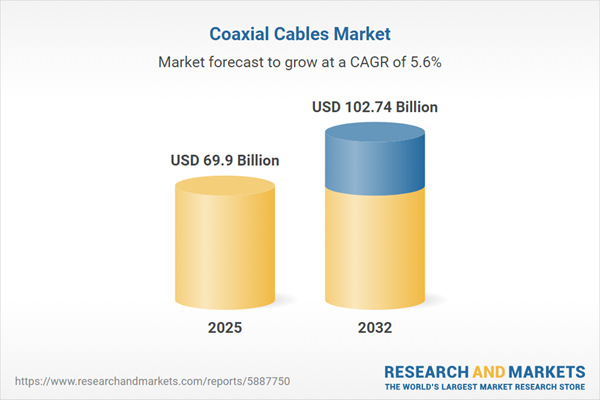Speak directly to the analyst to clarify any post sales queries you may have.
As digital transformation accelerates and compliance pressures evolve, the coaxial cables market remains essential for organizations building resilient communication frameworks. Senior executives are redefining supplier strategies and adopting adaptable networking solutions to achieve operational agility and meet industry developments head-on.
Market Snapshot: Coaxial Cables Market Size and Growth Outlook
The global coaxial cables market is projected to rise from USD 66.23 billion in 2024 to USD 69.90 billion by 2025, reaching USD 102.74 billion by 2032 at a CAGR of 5.64%. This sustained trajectory reflects increasing transitions to digital communications, substantive defense infrastructure modernization, and consistent upgrades across diverse network environments. Enhanced conductor technologies and advanced shielding are establishing coaxial cables as a core resource in operating environments that demand high bandwidth, compliance, and resilience. As organizations across telecommunications, infrastructure, media, and defense intensify efforts to optimize connectivity, coaxial cables support a range of secure, high-uptime applications for current and future network needs.
Scope & Segmentation of the Coaxial Cables Market
- Cable Types: Flexible, rigid, and semi-rigid coaxial cables are engineered to meet distinct communication requirements in telecom, military, and broadcast media contexts. Their varying construction ensures durability during frequent installation cycles and reliability in challenging physical environments.
- Applications: Use cases span radio and television broadcast, CCTV infrastructure, satellite platforms, military electronics, and broadband service providers. These cables provide the adaptable connectivity that organizations need for network expansion, equipment upgrades, and regulatory compliance across regulated sectors.
- Conductor Materials: Copper-clad aluminum, solid copper, and stranded copper options let enterprises align cable performance with specific operational priorities like extended life and optimized signal consistency in both fixed and flexible settings.
- Shield Types: Single-braided, double-braided, aluminum foil, multi-layered, and unshielded designs safeguard signal integrity in environments with variable electromagnetic interference, simplifying deployment in data-sensitive or industrial settings.
- Jacket Materials: FEP, LSZH, PE, and PVC jackets—including flame-retardant versions—are specified to meet critical safety standards and enable dependable installation in environmentally demanding or mission-critical spaces.
- Impedance Options: Standardized 50 Ohm and 75 Ohm options support smooth integration with both contemporary and legacy radiofrequency, telecom, and broadcast infrastructure, contributing to backward compatibility and system stability for ongoing or retrofit projects.
- Geographic Regions: Market momentum is notable in the Americas, Europe, Middle East and Africa, and Asia-Pacific. The United States and China are prioritizing network modernization, India and Brazil demonstrate strong uptake, while the UK, Germany, Australia, Japan, UAE, South Africa, and South Korea are advancing regulatory alignment and infrastructure upgrades.
- Leading Companies: Industry leadership is shaped by Prysmian Group, Nexans, CommScope, Belden, Sumitomo Electric Industries, Amphenol, HUBER+SUHNER, Fujikura, Leoni, and Corning, who set quality, innovation, and standards benchmarks for the global coaxial cables market.
Key Takeaways for Senior Decision-Makers
- Maintaining reliable coaxial cable infrastructure is integral for network continuity and regulatory compliance, particularly across sectors with mission-critical operations.
- Shifting to lightweight, environmentally conscious materials positions organizations to advance sustainability goals and address evolving environmental mandates.
- Integrating coaxial solutions with fiber-optic backbones and cloud-based monitoring platforms enables organizations to elevate network management and address potential outages with predictive analytics.
- Diversified supplier relationships, including regional and local vendors, bolster supply chain resilience and support mitigation strategies for unexpected disruptions.
- Investment in automated workflows and technical alliances ensures infrastructure is well-positioned to accommodate future market requirements and fluctuating business demands.
Tariff Impact on United States Trade Flows
Recent adjustments to United States tariff policy are prompting organizations to revisit procurement strategies and supplier portfolios. In response, many companies are increasing domestic sourcing and optimizing inventory management to reinforce communications project continuity and fortify long-term infrastructure plans against potential volatility.
Methodology & Data Sources
This report draws on input from executive interviews, subject-matter expert roundtables, regulatory documentation, and contributions from independent advisors. These combined sources provide an unbiased view and actionable guidance based on the latest industry developments and regulatory trends.
Why This Report Matters
- Equips executives to coordinate sourcing, network planning, and technical upgrades in line with shifting connectivity and communications benchmarks.
- Supplies supply chain professionals with intelligence to anticipate market shifts, streamline vendor strategies, and proactively address risks in closely regulated spaces.
- Assists infrastructure leaders in scaling future-proof communications networks to support fresh business cases and evolving stakeholder requirements.
Conclusion
Grounded in current data and industry benchmarks, this report enables organizations to strengthen their communications frameworks, address new connectivity challenges, and support strategic positioning as the market evolves.
Additional Product Information:
- Purchase of this report includes 1 year online access with quarterly updates.
- This report can be updated on request. Please contact our Customer Experience team using the Ask a Question widget on our website.
Table of Contents
3. Executive Summary
4. Market Overview
7. Cumulative Impact of Artificial Intelligence 2025
Companies Mentioned
The companies profiled in this Coaxial Cables market report include:- Prysmian Group S.p.A.
- Nexans S.A.
- CommScope Holding Company, Inc.
- Belden Inc.
- Sumitomo Electric Industries, Ltd.
- Amphenol Corporation
- HUBER+SUHNER AG
- Fujikura Ltd.
- Leoni AG
- Corning Incorporated
Table Information
| Report Attribute | Details |
|---|---|
| No. of Pages | 188 |
| Published | October 2025 |
| Forecast Period | 2025 - 2032 |
| Estimated Market Value ( USD | $ 69.9 Billion |
| Forecasted Market Value ( USD | $ 102.74 Billion |
| Compound Annual Growth Rate | 5.6% |
| Regions Covered | Global |
| No. of Companies Mentioned | 11 |









